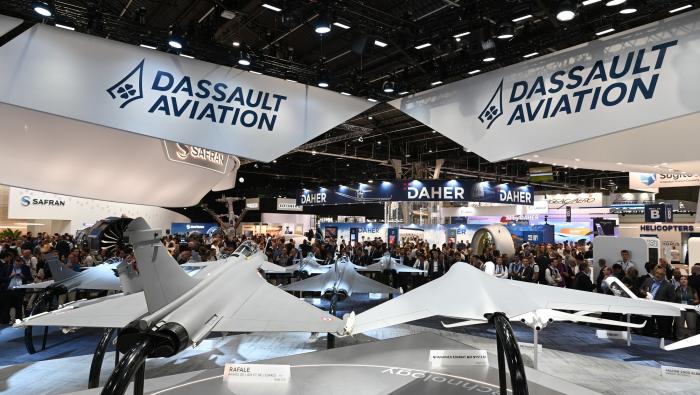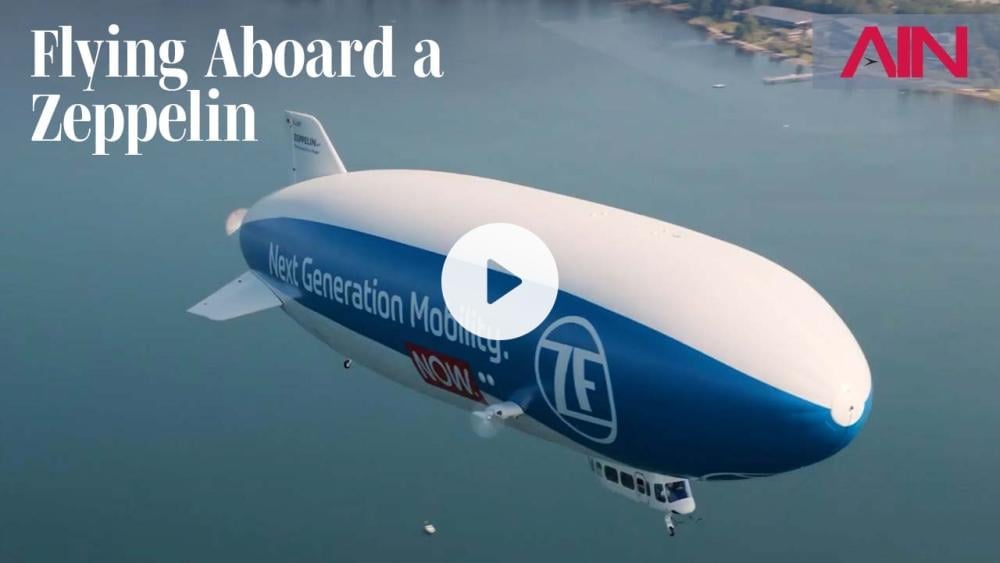|
Dassault Aviation’s defense activities generally contributed a stronger boost to its business jet unit in half-year financial results announced today. During a press conference in Paris outlining its first-half results, group CEO Éric Trappier warned that an unfavorable outcome to ongoing negotiations between the U.S. government and the EU over tariffs could dent Falcon sales. During the first six months, total order intake at Dassault grew by 57%, to €8.1 billion ($9.5 billion), from the €5.1 billion recorded in the same period last year. With eight Falcon business jets ordered during the first half—three less than last year—this generated €900 million in orders, which was slightly down on last year’s tally of €1 billion. By comparison, the group’s defense unit recorded orders worth €7.2 billion from export customers and its home customer, the French government. A highlight of the first half of the year was an order in April from India for 26 Rafale Marine combat airplanes, representing the first export order for this type. Twelve Falcons were delivered during the first half, unchanged from the first six months of last year. Trappier reported that the 6X fleet has now logged more than 3,400 flight-hours. |
|
|
Aircraft engine maker Pratt & Whitney is celebrating its 100th anniversary today, having entered the market with its R-1340 Wasp radial engine in 1925. The company, which is now part of the RTX aerospace and defense group, has more than 90,000 engines in service worldwide on a variety of airplanes and helicopters. Pratt & Whitney Aircraft Company was established after Frederick Rentschler convinced the Pratt & Whitney Machine Tool Company to back his plans to develop much lighter engines for future aircraft. In 1926, the U.S. Navy approved the 425-hp R-1340 Wasp, ordering 200 units for an early carrier-based aircraft. Over the next 20 years, Pratt & Whitney went on to significantly increase the power ratings of a series of Wasp engines for several warplanes, including hundreds of thousands produced for military use during World War II. After that conflict, Pratt & Whitney increasingly focused its attention on the development of jet engine technology, producing one of the world’s first twin-spool gas turbine engines. Today, Pratt & Whitney’s Geared Turbofan engine powers single-aisle airliners, including the Airbus A320neo and A220, and Embraer’s E2 family. It also produces the F135 engine for Lockheed Martin’s F-35 Lightning II fighter, and its Pratt & Whitney Canada division makes PW300, PW500, PW600, and PW800 turbofans for a wide variety of business jets. |
|
|
Epic Aircraft announced FAA type certification for its latest turboprop single, the E1000 AX, with customer deliveries set to begin this week from the company’s headquarters in Bend, Oregon. The E1000 AX made its public debut in April at the 2025 Sun ’n Fun Aerospace Expo in Lakeland, Florida, and now becomes the third FAA-certified aircraft in Epic’s lineup, following the E1000 in 2019 and E1000 GX in 2021. “Aircraft deliveries will begin this week at factory headquarters,” said Epic CEO Doug King. “We just completed a record-breaking sales quarter, and July is already the best sales month in company history. All 2025 E1000 AX production positions are filled, and sales are brisk for 2026 deliveries.” The AX boasts a maximum cruise speed of 333 knots, full-fuel payload of 1,177 pounds, 4,000-fpm climb rate, and a 1,560-nm range. Certified to operate at up to 34,000 feet, the AX introduces more than 25 enhancements. Garmin’s Autothrottle and Autoland systems are among these upgrades, though Autoland will only be activated upon final FAA approval. Others include an automatic yaw damper, electronic brake hold, and Garmin GDL 60 with PlaneSync, as well as optional Garmin 3D SafeTaxi and GWX 8000 StormOptix weather radar. Among the cabin and operational improvements are a True Blue Power lithium-ion battery, CoolView windows for UV protection and thermal shielding, and optional Starlink internet connectivity. |
|
|
Phoenix-based aircraft modification provider Blackhawk Group has been named as the exclusive distributor in North and South America for the engine/propeller replacement supplemental type certificate on the Piper Meridian turboprop single. Developed by MT-Propeller, the “X-Range” upgrade replaces the factory-installed Pratt & Whitney Canada PT6A-42A engine with the lighter PT6A-135A and MT’s five-blade composite MTC-27 Quiet Fan Jet propeller. It also includes a new exhaust system along with improved airbox components, engine mounting hardware, and brackets for the engine power control interface. Installed, the package boosts cruise speeds up to 258 ktas, improves fuel economy, and increases range up to 1,340 nm at 30,000 feet. The addition of a composite propeller reduces noise levels both within and outside the aircraft. “Blackhawk Group was the obvious choice for this program in the Americas,” said MT v-p Martin Albrecht. “Their deep experience with PT6A upgrades, reputation for excellence, and strong support network across North and South America made them the ideal partner to deliver this exciting upgrade to Piper Meridian owners.” Blackhawk also reached a milestone with the delivery of its 2,000th PT6A engine from Pratt & Whitney Canada since Blackhawk’s founding 25 years ago. |
|
|
Daher’s mobile app for managing safety and efficiency of its turboprop-single TBM series is now being developed for the company’s Kodiak utility airplanes and will offer similar features such as remote aircraft status, My Kodiak Docs, and contacts. The Me & My Kodiak app is under development and available now in a demo version, which Daher is showing this week at EAA AirVenture Oshkosh. To access remote aircraft status, Kodiak 100s and 900s equipped with Garmin GDL 60 datalink can share aircraft information via Garmin’s PlaneSync connected aircraft management system with authorized users. This includes fuel quantity, oxygen levels, TKS fluid levels, oil temperature, and battery charge. My Kodiak Docs provides access to the latest versions of maintenance manuals, illustrated parts catalogs, line maintenance manuals, service bulletins, briefing cards, and posters. Also available are aircraft information via the flight ops page and a resources page with “a full range of aircraft information and knowledge,” according to Daher, as well as a maintenance page with maintenance documentation. For access to Daher’s customer support team, the app has a contacts feature for quick connection to the right people. Other app functionality includes a My Flight Crew page that enables sharing information with authorized pilots and crews and the My Kodiak Fleet Page for managing multiple Kodiaks. |
|
|
Romanian charter group Toyo Aviation has become the first aircraft operator in the country to be approved to use paperless electronic technical logbooks. TrustFlight today announced that Romania’s civil aviation authority had granted permission for Toyo to deploy its Tech Log system. Bucharest-based Toyo operates a fleet of six aircraft, including Cessna Citation M2s and CJ4s; Bombardier Challenger 300s; and Embraer Legacy 600s and 650s. Since its launch in 2007, the company has operated flights across Europe, as well as in Africa, Asia, and the U.S., and also offers aircraft management and CAMO services. Toyo now uses both the TrustFlight Tech Log and Centrik 5 safety and quality management systems. According to UK-based TrustFlight, the platforms help operators to harmonize processes between flight operations and aircraft maintenance teams. Tech Log, which is now in service with 44 business aircraft operators, has been developed to streamline maintenance workflows by automatically validating any errors and reducing the time taken to manually input and process data. According to TrustFlight, the system supports real-time communication between flight crews and technicians, giving ground personnel immediate knowledge of any problems to boost safety and reduce aircraft downtimes. “The successful implementation of TrustFlight’s electronic Tech Log represents a significant step forward in our digital transformation journey,” said Gheorghe Oprea, Toyo Aviation’s compliance monitoring and safety manager. |
|
|
Zeppelins Span Aviation’s Past, Present, and Future AIN’s Amy Wilder takes a breathtaking ride in a Zeppelin in the airship’s hometown of Friedrichshafen, Germany. |
|
|
|
|
|
|
AINalerts News Tips/Feedback: News tips may be sent anonymously, but feedback must include name and contact info (we will withhold name on request). We reserve the right to edit correspondence for length, clarity, and grammar. Send feedback or news tips to AINalerts editor Chad Trautvetter. |
|
AINalerts is a publication of AIN Media Group, 214 Franklin Avenue, Midland Park, New Jersey. Copyright 2025. All rights reserved. Reproduction in whole or in part without permission is strictly prohibited. |















